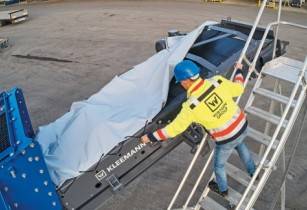Bosch Industriekessel GMBH developed double-flue boilers in three-pass compact technology during the 1950s and builds them today with capacities up to 55 t/h: the pioneering factor is still regarded as being the continuous separation of the two burners and their flue tubing right through to the flue gas chamber
The ZFR boiler series was patented and the design principle of that patent has been retained until today. But the boiler details have inevitably been further developed, due to the progress that has been made and the increasing diversity of the systems used.
Double-flue boilers are more cost-effective than two single-flue boilers, less space is required, less installation and maintenance work is required, and higher operating pressures are possible.
The boiler floor and flame tubes and the boiler floor and flue gas reversing chamber must be rigidly anchored to each other. Thermal expansion is absorbed without problems in this case by the front boiler floor, which is made more dynamic. In addition, it is a good sign if the boiler water can flow around without impedance, and if it passes the heating surfaces quickly thus providing a thermal balance in the boiler which is as even as possible.
High-capacity boilers ? as double-flue boilers now are ? should always have an economiser, ideally mounted on a piggy-back basis. Double-flue boilers which sometimes work with just one boiler consequently also have separate flue gas conduits in the economiser. There are two types of separated flue gas circulation: a complete economiser for the first and the second burner, or, alternatively, a single economiser body with a central flue gas separating wall, but continuous water tube bundles for both burners.
Double-flue boilers have two individual burners and this opens up the possibility of expanding the control range. The regulation of both burners in parallel operation is easily conceivable here. But the fact is that every time there is an operating fault in a burner because of a blockage in the fuel flow or a defect, the other cannot operate either. An emergency operation with just one burner is not possible, nor is sequence control of the burners. The only advantages of parallel operation lie in the rather smaller system costs: the blower, load regulator, automatic firing device and gas filter, gas shutoff valve and gas pressure regulator for gas burners can be shared equipment.
Double-flue boilers cover a high heat requirement. It has been found in practice that there are also times when operation with just one burner is important: in low-load phases and in the event of faults on one of the two burners. Double-flue boilers which allow an unlimited single operation of the burners offer excellent load flexibility and minimise switching on and off, which wastes fuel and causes boiler wear.
In the evaluation of various double-flue boiler designs, attention should also be paid to a long working life without damage. This applies for steam boilers as much as it does for hot water boilers. If a double-flue boiler is designed and approved for unlimited single operation of the burners, this is tested by the T?V test authority. It is important to ask the boiler supplier to provided this certificate. It is also important to inspect reference systems which have been in operation for 10 years or more, and which have to cope with changing loads and which are used extensively all year round. With double-flue boilers in particular, reliability and technical expertise are selection criteria that should not be underestimated.
READ MORE...
From an original article by Jochen Loos and Markus Tuffner of Bosch Industriekessel GmbH. To read the article in full go to www.bosch-industrial.com/files/fb003_en.pdf



























